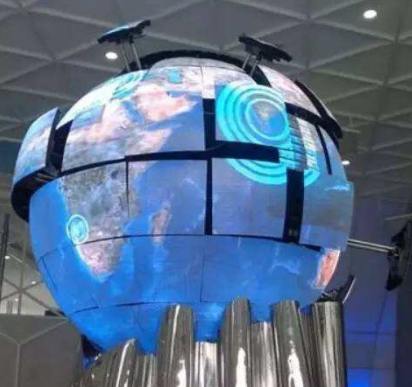The LED spherical screen is a relatively new technology that has only emerged in recent years. Its primary function is to allow viewers to see the displayed content from all directions, creating a 360-degree visual experience. This innovative display method offers a fresh and immersive way to present information or entertainment. But how does the LED spherical screen work? What are its key features, and what types of products are available on the market today? Let's explore these questions in detail.

First, let’s understand the basic principle behind the LED spherical screen:
The system is composed of several core components, including a control module, a rotating display unit, a wireless communication module, a font library module, a motor drive system, and a power supply. The fan blade, which is designed to be circular, is embedded with a ring of LED lights. These LEDs can be monochromatic or multi-colored. As the fan blade rotates around its central axis, it creates a spherical surface. With the help of specialized software, the system can illuminate specific points on the sphere as the fan moves, allowing for precise control over the displayed content.
Second, the characteristics of the LED spherical screen include:
1. One of the main reasons for the popularity of the rotating LED spherical screen is its ability to offer a fresh and unique viewing experience. In an era where people are tired of flat displays, this 3D rotating screen provides a visually striking alternative. Even if some distortion occurs when playing standard video content on a spherical surface, it is generally accepted, much like how fisheye photos are embraced for their creative effect.
2. The resolution design of the LED spherical screen follows similar principles to those of traditional LED displays. The choice of pixel pitch (P1, P2, P3, etc.) depends on the viewing distance. For instance, if the audience is about 2.5 meters away, a P2.5 or P2 model is recommended. If the distance increases to 6 meters, P5 or P6 models are more suitable. If budget allows, higher-resolution options like P4 or even P3 can be considered. For outdoor use at a distance of 10 meters, a P10 model is typically used. However, these are general guidelines and should be adjusted based on the actual installation environment, audience size, and budget.
Third, there are different types of LED spherical screens available in the market:
1. Watermelon Skin LED Spherical Display:
This type uses a PCB shaped like a watermelon. It is easy to understand structurally and uses smaller PCBs. However, it has a significant drawback: the north and south poles (above 45° latitude and below 45° latitude) cannot display images properly, leading to low screen utilization or severe image distortion. This is because the pixel arrangement on these areas is circular rather than linear, making it difficult to render accurate images.
2. Triangular LED Spherical Display:
Also known as a soccer ball screen, this design uses triangular PCBs. It solves the issue of the north and south poles found in the watermelon skin version, significantly improving screen utilization. However, it comes with its own challenges, such as a large number of PCB types, limited dot pitch due to the honeycomb layout, and complex software programming.
3. Six-Sided LED Spherical Display:
This type of screen is made up of quadrilateral PCBs, offering a structure closer to traditional flat LED displays. It allows for a smaller dot pitch, similar to that of flat panels, and provides better image quality compared to the triangular version. This makes it a more versatile and visually appealing option for various applications.
automatic mechanical watch,mechanical watch box,mechanical watch components,automatic watch movement
Dongguan Yingxin Technology Co., Ltd. , https://www.dgyingxintech.com
